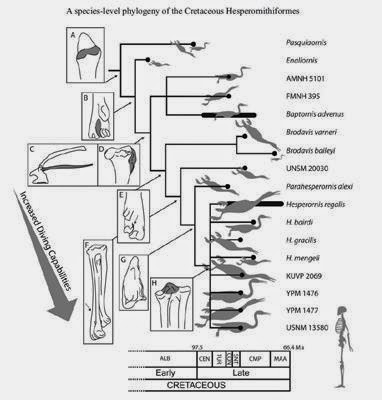| Online: | |
| Visits: | |
| Stories: |

| Story Views | |
| Now: | |
| Last Hour: | |
| Last 24 Hours: | |
| Total: | |
Go Fish! Ancient Birds Evolved Specialist Diving Adaptations
Living at the same time as the dinosaurs, Hesperornithiform bird fossils have been found in North America, Europe and Asia in rocks 65–95 million years old. Dr Alyssa Bell and Professor Luis Chiappe of the Dinosaur Institute, Natural History Museum of Los Angeles County, publishing in the Journal of Systematic Palaeontology, have undertaken a detailed analysis of their evolution, showing that separate lineages became progressively more adept at diving into water to catch fishes, like modern day loons and grebes.
Evolution of diving specializations within the Hesperornithiformes.
Credit: Taylor & Francis
The results of this study confirm that the Hesperornithiformes do form a single group (or clade), but that within this group the inter-relationships of the different taxa are more complex than previously thought. Additionally, this study finds that anatomical changes were accompanied by enlargement in overall body size, which increased lung capacity and allowed deeper diving.
Overall, this study provides evidence for understanding the evolution of diving adaptations among the earliest known aquatic birds.
Contacts and sources:
Taylor & Francis
Source: http://www.ineffableisland.com/2015/05/go-fish-ancient-birds-evolved.html




